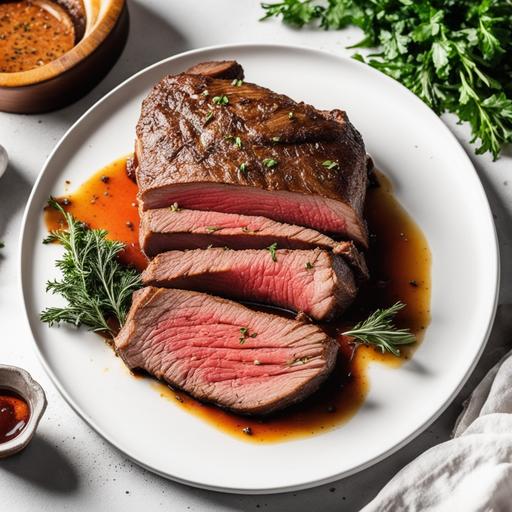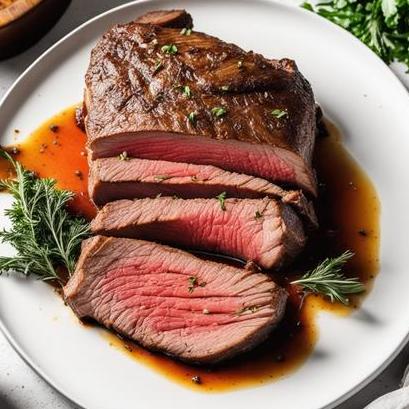
Rump Roast Oven Recipe: The Perfect Method For Succulent Beef
When it comes to preparing beef, few cuts compare to rump roast. Its rich, beefy flavor and succulent, juicy texture make it a frequent go-to for Sunday evening dinners, holiday feasts, and everything in between.
Cooking rump roast in the oven is one of the easiest and most reliable methods, and it’s perfect for novice cooks or anyone looking for a hassle-free meal that’s sure to impress.
But before we dive into the recipe, let’s first discuss some of the culinary details and food science behind rump roast.
What is Rump Roast?
Rump roast is a cut of beef taken from the hindquarters of a cow. It is a lean and flavorful cut that’s commonly used for roasting, braising, and slow cooking. It is sometimes referred to as Bottom Round Roast.
Selecting and Cleaning Rump Roast
When selecting rump roast, it’s essential to look for fresh and top-quality cuts of meat. The meat should have a bright, deep red color and be free from any discoloration or blemishes.
Before cooking, make sure to rinse the roast under cold water to remove any excess blood or bacteria. Pat it dry with paper towels, and then let it sit at room temperature for thirty minutes before cooking.
Preparing Rump Roast for Oven Cooking

The crucial first step in preparing rump roast for oven cooking is to season it well. You can use your favorite seasoning blend or try the following recipe:
-
1 tablespoon of kosher salt
-
1 tablespoon of black pepper
-
1 tablespoon of garlic powder
-
1 tablespoon of onion powder
-
1 tablespoon of smoked paprika
-
1 teaspoon of dried thyme
Combine these seasonings in a small bowl and mix well. Then, rub the mixture all over the rump roast, making sure to coat it evenly.
Next, preheat your oven to 350°F. Place the rump roast in a roasting pan with the fat side up and insert a meat thermometer into the thickest part of the roast. Add a cup of beef broth or water to the bottom of the pan to prevent the meat from sticking.
Tips and Variations

-
For added flavor, you can marinate the rump roast overnight with your favorite marinade before cooking.
-
You can also add vegetables such as potatoes, carrots, and onions to the roasting pan for a one-pan meal.
-
You can also turn the roast halfway through cooking to help it brown evenly on both sides.
-
Big chunks of uncooked rump roast can be slow-cooked in sauces to make stews, like beef barbacoa, just shredding pieces of meat after.
How to Check if Rump Roast is Done

Measuring the internal temperature of the rump roast is the most reliable method to determine if it’s cooked to your desired level of doneness.
Here is a quick guide for different levels of doneness and their corresponding temperatures:
-
Rare: 120°F – 125°F (49°C – 52°C)
-
Medium-rare: 130°F – 135°F (54°C – 57°C)
-
Medium: 140°F – 145°F (60°C – 63°C)
-
Medium-well: 150°F – 155°F (66°C – 68°C)
-
Well-done: 160°F – 165°F (71°C – 74°C)
Keep in mind that the meat will continue to cook for a few minutes after you remove it from the oven, so it’s best to take it out when the thermometer reads about five to ten degrees cooler than your desired temperature.
Recipe for Rump Roast in the Oven

Now that we’ve covered the culinary details, here’s a straightforward recipe that will help you to achieve the perfect rump roast in the oven every time.
Ingredients:
-
1 rump roast (3-4 pounds)
-
1 tablespoon of kosher salt
-
1 tablespoon of black pepper
-
1 tablespoon of garlic powder
-
1 tablespoon of onion powder
-
1 tablespoon of smoked paprika
-
1 teaspoon of dried thyme
-
1 cup of beef broth or water
Directions:
-
Preheat the oven to 350°F.
-
Combine the salt, black pepper, garlic powder, onion powder, smoked paprika, and thyme in a small bowl to make the seasoning blend.
-
Rub the seasoning blend all over the rump roast.
-
Place the rump roast fat side up in a roasting pan with a cup of beef broth or water in the bottom.
-
Insert a meat thermometer into the thickest part of the roast.
-
Cook the rump roast for 20-25 minutes per pound, or until the thermometer reads your desired temperature.
-
Remove the roast from the oven and let it rest for 10-15 minutes before slicing and serving.
Avoid Overcooking or Undercooking Rump Roast
The most common mistakes people make when cooking rump roast in the oven are overcooking or undercooking it.
Overcooked rump roast can become dry, tough, and rubbery; on the other hand, undercooked rump roast can be chewy and unpleasant.
By following the steps and temperature guidelines in this recipe, you can ensure that your rump roast is cooked to perfection every time.
Conclusion
Rump roast is a delicious and budget-friendly cut of beef that’s perfect for oven-roasting. With the right seasonings, cooking methods, and temperatures, you can achieve a succulent and flavorful roast that’s sure to impress.
Remember to select top-quality cuts, prepare them correctly, use the right temperatures, and take your time to perfect your cooking technique.
With these tips, your rump roast will be the talk of the dinner table, and your family and friends will rave about it for days to come.
Sources
FAQS On Rump Roast Oven Recipe
What Cut Of Meat Is Best For A Rump Roast Oven Recipe?
The rump roast is a popular choice for oven recipes due to its flavorful and tender nature. It is taken from the hindquarter of the beef, specifically from the backside of the animal, making it a lean cut with minimal fat marbling. This cut of meat is ideal for roasting as it retains its tenderness and juiciness when cooked slowly in the oven.
How Long Should I Cook A Rump Roast In The Oven?
Cooking time for a rump roast in the oven can vary depending on the size of the roast and desired doneness. As a general guideline, preheat your oven to 325°F (163°C) and cook the roast for about 20 minutes per pound. However, it is essential to use a meat thermometer to ensure the roast reaches an internal temperature of 145°F (63°C) for medium-rare or 160°F (71°C) for medium doneness.
Should I Marinate The Rump Roast Before Cooking?
While marinating the rump roast is not necessary, it can certainly enhance the flavor of the meat. The lean nature of the rump roast benefits from tenderizing and flavor-boosting marinades. If you choose to marinate the roast, it is recommended to do so for at least 4 hours or overnight in the refrigerator. A marinade consisting of herbs, garlic, soy sauce, Worcestershire sauce, and olive oil can add depth and tenderness to the roast.
How Do I Properly Season A Rump Roast For The Oven?
To maximize the flavor of your rump roast, generously season it with a combination of salt, freshly ground black pepper, and any desired herbs or spices. The salt helps to enhance the natural flavors of the meat, while the pepper adds a subtle kick. Common herbs and spices to complement a rump roast include rosemary, thyme, garlic powder, and paprika. Rub the seasonings evenly onto the surface of the roast before placing it into the oven.
Should I Sear The Rump Roast Before Baking It In The Oven?
Searing the rump roast before baking is an optional step that can help enhance the flavor and appearance of the meat. Searing involves browning the surface of the roast over high heat to develop a flavorful crust. While it is not essential, searing can add depth and complexity to the final dish. To sear the rump roast, heat oil in a skillet over medium-high heat, and then brown each side of the roast for a few minutes before transferring it to the oven.



